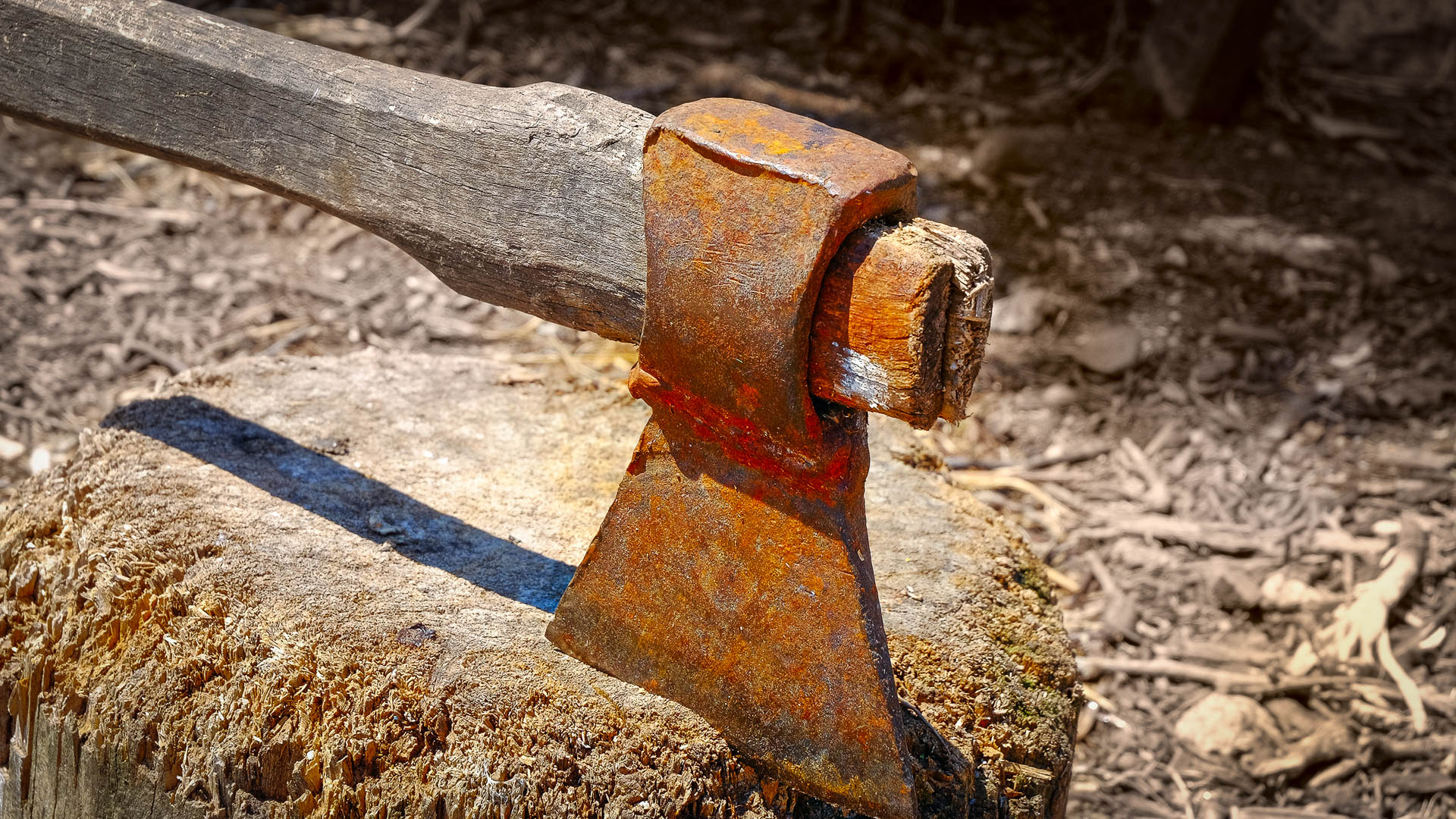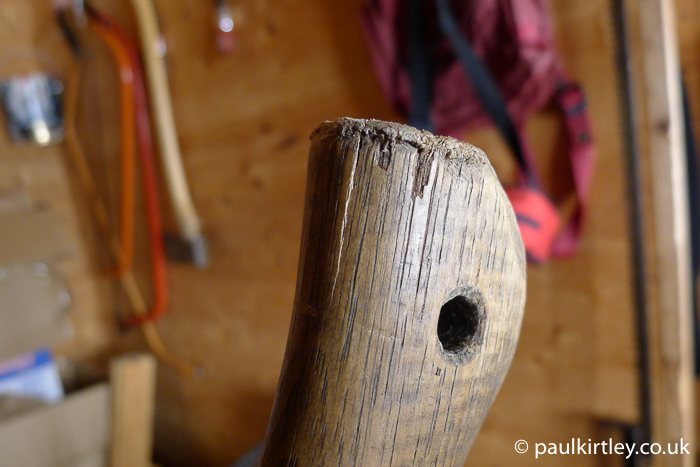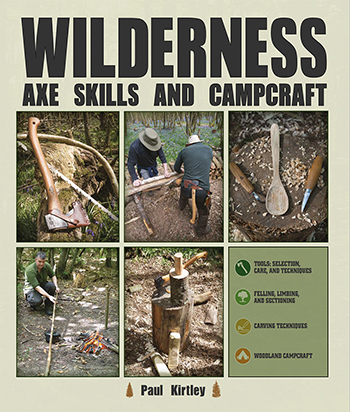
How To Spot A Dangerous Axe
While it is generally bad form to ask to borrow someone else’s axe, if you travel in wild and remote places, you will likely end up using axes that are not your own. In my experience this most often occurs if you are staying in wilderness camps, remote cabins or huts with axes already in the woodshed, or if you have been provided with an axe as part of a larger outfitting of equipment, on a canoe trip for example.
While in the case of outfitting, axes are usually sound, in other cases they are frequently not in a condition you would keep your own tools. So, it’s worth assessing the safety (or otherwise) of an axe before you start using it with any vigour. The photographs below are all of axes I have encountered on my travels and are representative of the types of damage you should be wary of.

What’s The Overall Picture Of The Axe?
The overall impression of the axe will give you an idea of its state of repair before you even pick it up. Does the axe look well cared for or is it a rusty mess of a head mounted on a bleached, cracked stick of a handle? Even if the axe doesn’t look too bad, it’s worth picking up the axe and having a closer look at some key aspects that can affect its safety in use.


Look For Damage To The Axe Handle
What does the finish of the handle look like? Is it in good condition, either close to how it would have been supplied or having been oiled regularly? Or is the handle finish chipped, battered or otherwise neglected?
If the axe handle looks somewhat battered, it can signify neglect and possibly misuse, and there may well be other issues with the tool. Even handles of well-maintained axes do sometimes crack, albeit rarely. Check for visible splits or finer cracks running along the grain of a handle.
What if there is more severe damage to the handle? In particular, is there is a lot of damage to the handle just back from the head?
This is the type of wear and tear that can occur when axes are used to split large pieces of wood, whereby the fibres in the wood abrade the wood of the axe handle. This wear can be mixed with overstrike damage, which occurs when attempting to split wood of a smaller diameter but overshooting the round with the head, instead hitting it with the underside of the handle.
If there is a big scallop of material missing from the axe handle here, you have to ask the question of how long will it be before the handle snaps?




Look For Damage To The Axe Head
Hitting an axe onto, or with, a heavy metal object like a hammer or another axe is generally a bad idea. Generally the metal of the poll and metal around the eye is softer than the working end of the axe. The polls of most axes are not sufficiently hardened to be struck in such a manner without deforming. You see this type of damage a fair bit in axes that have been hit poll-to-poll with other axes.
Unless an axehead has been hardened to withstand metal-on-metal blows, impacts from other axes, even identical axes, will cause damage to the head, notably flattening of the poll. In extreme cases this damage is called mushrooming, where the poll literally resembles a mushroom due to the amount of metal pushed down over the top of the poll. Heavy blows with metal objects will also potentially deform the eye. This deformation will potentially make the handle loose, especially if the wood in the eye is crushed.



Look For Movement Of The Axe Head
A loose axe head is an accident waiting to happen. How loose is it? When will it come off entirely? How hard would you have to swing the axe for the head to fly off? And where would it go? While it’s possible a loose head may physically move relative to the handle when you try to move the two independently, one in each hand, movement of the head is not always detected this readily.
A head may feel fast on the handle yet it may not be. We can look for other signs such as a “tan line” on the handle, where movement of the head has revealed wood underneath that is not as dark/light as the rest of the handle. There may be a line of dirt where the head used to lay against the handle. There may even be some visible damage or scraping on the surface of the handle from when the head was first pressed onto the handle. There could also be similar signs of the head having been repeatedly pushed or hammered back up the handle after coming loose.




Look An Axe In The Eye
While you shouldn’t look a gift horse in the mouth, you should certainly look an unfamiliar axe in the eye, gifted or not. Mixed metaphors notwithstanding, the eye of an axe will reveal a good amount of information about the fastness of the head. Indeed, it’s largely what’s going on in the eye that keeps the head on an axe.
You should check the eye of an unfamiliar axe has all the wood it should have. The ends of the handles should be complete, as should the wedge. Axes are hung on their handles typically with the handle protruding a short distance beyond the head. If the end of the handle is recessed into the eye, then you should suspect the head is working its way off the end, even if it doesn’t feel loose.



The wood in the eye can rot, particularly if an axe is habitually kept head-down on damp ground. The so-called lanyard hole in the handle is really there so you can hang the axe on a nail, up away from the damp floor of a woodshed. I’ve picked up axes in cabin woodsheds and found the wedge almost entirely missing with woodlice living in there instead.



Take Responsibility For Your Safety
Neglected or misused axes can easily have safety issues. Just because someone has left an axe in a woodshed for anyone to use does not mean it is safe to do so. Moreover, because anyone and everyone might have used an axe, often in inappropriate ways, means it’s incumbent on you to check the axe is up to the job you want to use it for. The above checks are simple to do and will reveal any major issues the axe might have.

Final Remarks On These Indicators
If you needed any proof of the assertion that lending your axe to someone is generally a bad idea, the above photos of neglected and abused axes should be enough. The images here also demonstrate training in good technique is worthwhile and, in the case of most people, necessary. No-one is born with innate axe skills! Further, undertaking some simple steps to care for an axe will greatly extend its life, service, and safety!
My Wilderness Axe Skills And Campcraft Book
Find out more at wildernessaxeskills.com
Related Materials On Paul Kirtley’s Blog….
Fjelltur: A Norwegian AdventureOptimising A General Purpose Axe And Saw Combo For Wilderness TravelHow To Care For Your Axe: 3 Easy StepsAxe Safety In Camp: Care, Attention And Good HabitsApplying Axe Skills In WinterBushcraft Show Axe Skills DemoSharing Bushcraft Techniques, Tips & Tricks During An Overnighter

8 thoughts on “How To Spot A Dangerous Axe”
Found a couple like this in the cabins on the training area at CFB Petawawa in Canada, however, it was mid Summer and we didn’t need to chop wood and we had army hexamine cookers with us. I think we just looked at the tools and put them back.
We used these cabins just for overnight stays while having a few days off fishing from the project we had on the training area. The place had a large population of black bears, skunks and Porcupines so we were better off in one of the cabins. We left Army compo rations in these places to say the Royal Engineers had been there.
There was also a couple billhooks that had seen better days the handles rotted
A good article as always. In a wind shelter a few kilometers awat from where I live I found an axe. The edge looked like a saw!
I usually see axes in this state on the local market. Though it works for me because they’re dirt cheap and if I can I just fix them up with a new handle. A bit of work and you can have some really good quality axes for pocket money prices.
A good article, but a little, “what to do about it,” for risk mitigation would had helped. A head just starting to move can be re-seated by tapping the end of the handle on the ground if it is not too far gone. How about carrying a small wedge in your repair kit?
A good and necessary article for anyone coming into bushcraft and outdoor life. Sadly, many old axes are un-necessarily abused and neglected. I have used axes for over 50 years and refurbished and repaired many. In my opinion, it is crucial to understand the importance of axe maintenance and repair concurrently with safe axe use/ axemanship. When I emigrated to Canada from Yorkshire in England several of my axes became loose on the haft because I moved into an arid area.
The 10th and 11th pictures of the narrative show the same axe with a loose head. That is only part of the problem. The handle is on the wrong way, in the sense that the belly is where the back should be and vica versa. The raised part of the shoulder should be above the eye and not below it, if you follow what I am saying. I’m surprised that you did not pick up on it yourself. Anyway, it was an enlightening article.
Thanks Michael. I’ve now added this observation explicitly to the photo captions.
Warm regards,
Paul
I received a Council tool axe today. There is split , cracked wood where it was hung. I was told it would be fine. I was wondering if I could send you a photo and get your opinion ?
Thanks so much !